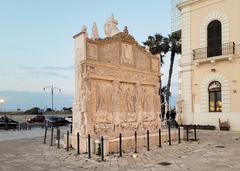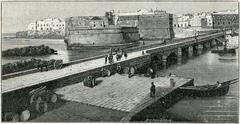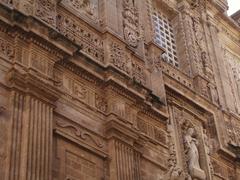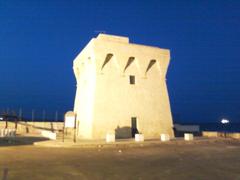
Guide to Visiting Fontana Greca in Gallipoli, Italy
Date: 18/08/2024
Introduction
Nestled in the heart of Gallipoli, Italy, the Fontana Greca is a captivating monument that stands as a testament to the town’s rich historical and cultural heritage. Often cited as one of the oldest fountains in Italy, the Fontana Greca is shrouded in historical ambiguity, with some sources suggesting its origins date back to the 3rd century BCE during the Hellenistic period (GallipolinelSalento). Others argue that it was constructed during the Renaissance period around the 16th century (Wikipedia). Despite the debate over its exact origins, the Fontana Greca’s intricate carvings, mythological bas-reliefs, and structural grandeur make it a must-visit landmark for history enthusiasts and casual travelers alike. Located near the Ponte Antico, the fountain is easily accessible and offers a unique glimpse into the artistic sensibilities and cultural influences that have shaped Gallipoli over the centuries.
Table of Contents
- Introduction
- Historical Background
- Architectural Features
- Cultural and Artistic Significance
- Visitor Experience
- FAQ
- Conclusion
- Sources
Historical Background
The Fontana Greca, located in Gallipoli, Italy, is a monument shrouded in historical ambiguity and cultural significance. It is often cited as the oldest fountain in Italy, with some sources suggesting its origins date back to the 3rd century BCE, during the Hellenistic period (GallipolinelSalento). This attribution is based on the stylistic elements that resemble ancient Greek art and architecture. However, other historians argue that the fountain was constructed during the Renaissance period, around the 16th century (Wikipedia).
The fountain was originally located near the ancient thermal baths, known as ‘funtaneddhe,’ and was later moved in 1548 to the vicinity of the now-defunct Church of San Nicola. By 1560, it was relocated to its current position near the Ponte Antico, adjacent to the Castello Angioino (GallipolinelSalento).
Architectural Features
The Fontana Greca stands approximately 5 meters tall and features two distinct facades. The North-West facade, which dates back to 1765, serves a structural function and is adorned with the coat of arms of Gallipoli, depicting a crowned rooster with the Latin inscription “fideliter excubat,” meaning “vigilantly watches” (GallipolinelSalento). This facade also prominently displays the insignia of King Charles III of Bourbon.
The South-East facade is the more ornate of the two, featuring intricate bas-reliefs that depict three mythological scenes: the metamorphoses of Dirce, Salmacis, and Byblis. These scenes are rooted in Greek mythology and add to the fountain’s enigmatic allure (ItalyTravelExpert).
Cultural and Artistic Significance
The Fontana Greca is not just a historical artifact but also a cultural symbol that encapsulates the rich tapestry of Gallipoli’s past. The fountain’s design elements, which include mythological figures and intricate carvings, reflect the artistic sensibilities of the period in which it was constructed. The use of mythological themes is particularly significant, as it underscores the influence of Greek culture on the region, even if the exact date of the fountain’s construction remains a subject of debate (Wikipedia).
The fountain’s relocation history also speaks volumes about its importance to the local community. Each move—from the thermal baths to the Church of San Nicola, and finally to its current location—was undertaken to preserve and showcase this architectural marvel. This indicates the high regard in which the fountain has been held over the centuries (GallipolinelSalento).
Visitor Experience
For tourists, the Fontana Greca offers a unique glimpse into the historical and cultural fabric of Gallipoli. Located near the Ponte Antico, the fountain is easily accessible and can be visited as part of a broader exploration of the city’s historical landmarks. Nearby attractions include the Castello Angioino, a 13th-century Byzantine castle that has been rebuilt multiple times and now houses a museum (ItalyTravelExpert), and the Gallipoli Cathedral, a baroque basilica dedicated to Saint Agatha (BeautifulPuglia).
Practical Information for Visitors
- Location: The Fontana Greca is situated near the Ponte Antico, which connects the old town of Gallipoli to the newer part of the city.
- Accessibility: The fountain is easily accessible on foot and is located near other major attractions, making it a convenient stop on a walking tour of Gallipoli.
- Best Time to Visit: The fountain can be visited year-round, but the best time to explore Gallipoli is during the spring and fall when the weather is mild and the tourist crowds are smaller.
- Visiting Hours: The Fontana Greca is accessible to the public at all times as it is an open-air monument.
- Ticket Prices: There is no entrance fee to visit the Fontana Greca.
- Nearby Attractions: In addition to the Castello Angioino and Gallipoli Cathedral, visitors can explore the Sanctuary of the Madonna del Canneto, the Port of Gallipoli, and the underground oil mills (Frantoio ipogeo) (BeautifulPuglia).
- Special Events and Guided Tours: Occasionally, guided tours and cultural events are organized around the Fontana Greca. Check local tourism websites or inquire at the Gallipoli tourist information center for the latest updates.
FAQ
- What are the visiting hours for Fontana Greca? The Fontana Greca is accessible to the public at all times as it is an open-air monument.
- Is there an entrance fee to see Fontana Greca? There is no entrance fee to visit the Fontana Greca.
- Are there guided tours available? Occasionally, guided tours are organized. Check with the Gallipoli tourist information center for the latest updates.
Conclusion
The Fontana Greca stands as a testament to the rich historical and cultural heritage of Gallipoli. Whether it dates back to the Hellenistic period or the Renaissance, its artistic and architectural features make it a must-visit landmark for anyone interested in the history and culture of southern Italy. The fountain’s intricate carvings, mythological themes, and historical significance offer a captivating experience for tourists and history enthusiasts alike.
References
- GallipolinelSalento. (n.d.). Fontana Greca. source url
- Wikipedia. (n.d.). Fontana Greca. source url
- ItalyTravelExpert. (n.d.). Gallipoli. source url
- BeautifulPuglia. (n.d.). Gallipoli. source url




